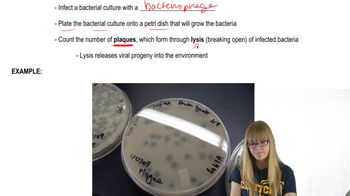To create a cDNA library, cDNA can be inserted into vectors and cloned. In the analysis of cDNA clones, it is often difficult to find clones that are full length—that is, many clones are shorter than the mature mRNA molecules from which they are derived. Why is this so?
Table of contents
- 1. Introduction to Genetics51m
- 2. Mendel's Laws of Inheritance3h 37m
- 3. Extensions to Mendelian Inheritance2h 41m
- 4. Genetic Mapping and Linkage2h 28m
- 5. Genetics of Bacteria and Viruses1h 21m
- 6. Chromosomal Variation1h 48m
- 7. DNA and Chromosome Structure56m
- 8. DNA Replication1h 10m
- 9. Mitosis and Meiosis1h 34m
- 10. Transcription1h 0m
- 11. Translation58m
- 12. Gene Regulation in Prokaryotes1h 19m
- 13. Gene Regulation in Eukaryotes44m
- 14. Genetic Control of Development44m
- 15. Genomes and Genomics1h 50m
- 16. Transposable Elements47m
- 17. Mutation, Repair, and Recombination1h 6m
- 18. Molecular Genetic Tools19m
- 19. Cancer Genetics29m
- 20. Quantitative Genetics1h 26m
- 21. Population Genetics50m
- 22. Evolutionary Genetics29m
18. Molecular Genetic Tools
Methods for Analyzing DNA
Problem 17b
Textbook Question
A 2-kb fragment of E. coli DNA contains the complete sequence of a gene for which transcription is terminated by the rho protein. The fragment contains the complete promoter sequence as well as the terminator region of the gene. The cloned fragment is examined by band shift assay. Each lane of a single electrophoresis gel contains the 2-kb cloned fragment under the following conditions:
Lane 1: 2-kb fragment alone
Lane 2: 2-kb fragment plus the core enzyme
Lane 3: 2-kb fragment plus the RNA polymerase holoenzyme
Lane 4: 2-kb fragment plus rho protein
Explain the relative positions of bands in lanes 1 and 3.
 Verified step by step guidance
Verified step by step guidance1
Step 1: Understand the components involved in the experiment. The 2-kb fragment contains the promoter sequence, the coding region, and the terminator region of the gene. The RNA polymerase holoenzyme is composed of the core enzyme and the sigma factor, which is responsible for recognizing the promoter sequence.
Step 2: Analyze Lane 1. This lane contains only the 2-kb DNA fragment. Since no proteins are bound to the DNA, the fragment will migrate freely through the gel based on its size and charge. This serves as the control for the experiment.
Step 3: Analyze Lane 3. This lane contains the 2-kb DNA fragment and the RNA polymerase holoenzyme. The sigma factor of the holoenzyme binds specifically to the promoter region of the DNA, forming a stable DNA-protein complex. This complex is larger and heavier than the unbound DNA, causing it to migrate more slowly through the gel compared to Lane 1.
Step 4: Compare the relative positions of bands in Lane 1 and Lane 3. The band in Lane 1 will be located further down the gel (closer to the bottom) because the unbound DNA migrates faster. The band in Lane 3 will be higher up the gel (closer to the top) due to the slower migration of the DNA-protein complex.
Step 5: Conclude that the difference in band positions between Lane 1 and Lane 3 is due to the binding of the RNA polymerase holoenzyme to the promoter region of the DNA, which increases the molecular weight and alters the migration rate of the DNA fragment in the gel.
 Verified video answer for a similar problem:
Verified video answer for a similar problem:This video solution was recommended by our tutors as helpful for the problem above
Video duration:
5mPlay a video:
Was this helpful?
Key Concepts
Here are the essential concepts you must grasp in order to answer the question correctly.
Transcription and RNA Polymerase
Transcription is the process by which RNA is synthesized from a DNA template. RNA polymerase is the enzyme responsible for this process, and it exists in two forms: the core enzyme, which can synthesize RNA but cannot initiate transcription, and the holoenzyme, which includes a sigma factor that allows it to bind to promoters and initiate transcription effectively.
Recommended video:
Band Shift Assay
A band shift assay, also known as an electrophoretic mobility shift assay (EMSA), is a technique used to study protein-DNA interactions. In this assay, DNA fragments are subjected to electrophoresis, and the presence of bound proteins alters the mobility of the DNA on the gel, resulting in distinct band patterns that indicate the binding of proteins such as RNA polymerase or rho protein.
Recommended video:
Guided course

Plaques and Experiments
Rho-Dependent Termination
Rho-dependent termination is a mechanism by which transcription is terminated in prokaryotes, specifically involving the rho protein. This protein binds to the RNA transcript and moves along it, eventually causing the RNA polymerase to dissociate from the DNA when it encounters a specific termination signal, leading to the release of the newly synthesized RNA.
Recommended video:
Guided course

Translation Termination

 7:40m
7:40mWatch next
Master Methods for Analyzing DNA and RNA with a bite sized video explanation from Kylia
Start learningRelated Videos
Related Practice
Textbook Question
547
views

